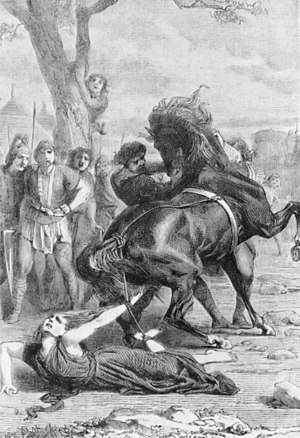Year 613 (DCXIII) was a common year starting on Monday of the Julian calendar. The denomination 613 for this year has been used since the early medieval period, when the Anno Domini calendar era became the prevalent method in Europe for naming years.
| Millennium: | 1st millennium |
|---|---|
| Centuries: | |
| Decades: | |
| Years: |
| Gregorian calendar | 613 DCXIII |
| Ab urbe condita | 1366 |
| Armenian calendar | 62 ԹՎ ԿԲ |
| Assyrian calendar | 5363 |
| Balinese saka calendar | 534–535 |
| Bengali calendar | 20 |
| Berber calendar | 1563 |
| Buddhist calendar | 1157 |
| Burmese calendar | −25 |
| Byzantine calendar | 6121–6122 |
| Chinese calendar | 壬申年 (Water Monkey) 3310 or 3103 — to — 癸酉年 (Water Rooster) 3311 or 3104 |
| Coptic calendar | 329–330 |
| Discordian calendar | 1779 |
| Ethiopian calendar | 605–606 |
| Hebrew calendar | 4373–4374 |
| Hindu calendars | |
| - Vikram Samvat | 669–670 |
| - Shaka Samvat | 534–535 |
| - Kali Yuga | 3713–3714 |
| Holocene calendar | 10613 |
| Iranian calendar | 9 BP – 8 BP |
| Islamic calendar | 9 BH – 8 BH |
| Japanese calendar | N/A |
| Javanese calendar | 503–504 |
| Julian calendar | 613 DCXIII |
| Korean calendar | 2946 |
| Minguo calendar | 1299 before ROC 民前1299年 |
| Nanakshahi calendar | −855 |
| Seleucid era | 924/925 AG |
| Thai solar calendar | 1155–1156 |
| Tibetan calendar | 阳水猴年 (male Water-Monkey) 739 or 358 or −414 — to — 阴水鸡年 (female Water-Rooster) 740 or 359 or −413 |

Events
editBy place
editByzantine Empire
edit- Emperor Heraclius marries his niece Martina; she becomes empress (Augusta) of the Byzantine Empire. This second marriage is considered to fall within the prohibited degree of kinship, and is approved by the Catholic Church in Constantinople.
- January 22 – Constantine is crowned co-emperor (Caesar) by his father Heraclius and shortly after betrothed to his cousin, Gregoria, daughter of Nicetas. Only 8 months old, Constantine has no real power and his dynastic title is purely ceremonial.
- Byzantine–Persian War: Heraclius appoints himself commander-in-chief, along with his brother Theodore (curopalates), to solidify command of the army.[1]
- Battle of Antioch: Heraclius mobilises a Byzantine expeditionary force to Antioch (Syria), but is completely defeated outside the city by the Persians. Shahin Vahmanzadegan makes further inroads into Central and Western Anatolia.[2] In Syria, Shahrbaraz captures the cities of Damascus, Apamea and Emesa.
Europe
edit- King Theuderic II dies of dysentery in the Austrasian capital of Metz, while preparing a campaign against his longtime enemy, Chlothar II. His grandmother Brunhilda attempts to establish a third regency for her illegitimate great-grandson Sigebert II.
- Chlothar II reunites the Frankish Kingdom by ordering the murder of Sigebert II. He accuses Brunhilda, age 70, of killing ten kings of the Franks (according to the Liber Historiae Francorum). She is dragged to death behind a wild horse at Abbeville.
Britain
edit- Battle of Chester: King Æthelfrith of Northumbria invades Gwynedd (northwest Wales), in order to route out his old enemy, Edwin of Deira. A united Brythonic force (Gwynedd, Powys, Pengwern and Dumnonian warriors) is defeated near Chester.[3]
Asia
edit- Goguryeo–Sui War: Emperor Yángdi crosses the Liao River again, and puts Manchuria under siege. During the campaign Yang Xuangan, an official of the Sui dynasty, starts a rebellion near Luoyang. Fearing attacks from two fronts, Yángdi is forced to retreat his army.
- Isanapura becomes the capital of the Cambodian kingdom of Chenla (approximate date).
By topic
editReligion
editBirths
editDeaths
edit- April 22 – Saint Theodore of Sykeon, Byzantine ascetic
- Bledric ap Custennin, king of Dumnonia (England)
- Brunhilda, queen of Austrasia
- Priscus, Byzantine general
- Sigebert II, king of Austrasia
- Theuderic II, king of Austrasia
- Uncelen, Duke of Alemannia (Germany)
- Yang Xuangan, official of the Sui dynasty
References
edit- ^ Walter Emil Kaegi (2003), Heraclius, Emperor of Byzantium, Cambridge University Press, p. 75. ISBN 0-521-81459-6
- ^ Foss 1975.
- ^ The Anglo-Saxon Chronicle (E) records this battle under the year 605, but this is considered incorrect; see Michael Swanton's translation of the ASC (1996, 1998, paperback), page 23, note 2. Between 613/616 is the generally accepted date, as first proposed by Charles Plummer, Venerabilis Beda Opera Historica (1896)
Sources
edit- Foss, Clive (October 1975), "The Persians in Asia Minor and the End of Antiquity", The English Historical Review, 90 (357): 721–747, doi:10.1093/ehr/XC.CCCLVII.721, JSTOR 567292